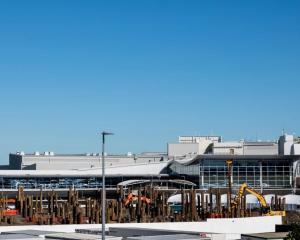
A teenager who suffered “massive and unsurvivable blood loss” after being fatally attacked by a great white was conscious and calling for help, yelling “Shark”, when rescuers reached her, a coroner's investigation has found.
The young woman was hauled aboard a boat and whisked back to shore for medical treatment but died from her injuries.
Coroner Michael Robb says there was nothing lifeguards could have done to prevent Kaelah Marlow’s death at Waihi Beach in January last year.
He recommends lifeguards should utilise drone technology to help them monitor ocean waters and conditions in and around flagged areas at beaches, and warn swimmers about the potential dangers of venturing beyond the breakers in areas that great whites are known to populate.
Marlow was swimming with a group of friends on January 7 last year when she was attacked by a 2.8m great white shark.
The incident happened shortly after the 19-year-old’s friends had returned to shore as they felt the current had become too strong, the report said.
The group had been swimming between the flags and the area was being patrolled by lifeguards at the time. The friends had been about 100m from the beach when they decided to head back. However, Marlow did not follow.
The report describes how lifeguards had been watching the group and a decision was eventually made for an inflatable rescue boat to head out to Marlow to check on her.
When the IRB was launched, the young woman was said to be about 300m to 400m away and did not look to be in any distress or “obvious difficulty,” according to the report.
Things took a turn for the worse, however, when Marlow was suddenly attacked by a shark before lifeguards had reached her.
A friend described seeing Marlow “panicking” and felt she was caught in a rip.
“Kaelah was really panicking and waving her arm around in the water before being pulled into the boat,” the friend said.
“Lifeguards reached Kaelah while she was conscious and calling for help and yelling ‘Shark’,” the decision says.
“Lifeguards lifted her into the boat and quickly transported her to shore and signalled for help.”
The attack was described as a “single massive bite”.
Another witness described seeing someone in the water “and something in the water around the person, which he thought at the time was seaweed or some other people”.
“He then watched from shore as the lifeguards pulled a limp body from the water into the IRB and immediately came back to the beach.”
The man helped lifeguards pull the boat onto shore. Marlow had “significant injuries” to her right thigh. The man applied pressure to the wound with his hands while a lifeguard applied a tourniquet.
“The woman was making noises but not responding to voices and she appeared to suffer a small seizure.”
A lifeguard recalled the moment they reached Marlow on an IRB and heard her “start to yell and scream”.
“She saw lots of blood in the water and the woman was yelling that she had been bitten by a shark.”
The report said Marlow had suffered “massive blood loss in a very short space of time” and despite efforts to save her life, she died at the scene.
“There was nothing that the lifeguards could have done to prevent Kaelah’s death on the information they had available to them.
“I conclude that the lifeguards were appropriately undertaking their responsibilities to observe Kaelah and were already actively taking action to check on her when she suffered her fatal injury.”
Robb went on to say that it was likely Marlow had already suffered “massive and unsurvivable blood loss” by the time lifeguards arrived and pulled her out of the water.
The coroner also gave recommendations that could help prevent a similar death or serious injury from a shark attack - or reduce the risk, at least, he said.
Recommendations included the consideration of having towers installed for lifeguards at beaches great white sharks are known to frequent, so they could have a better view of the beach.
Robb also recommended signs around the beach warning of sharks in the area as well as a statutory provision that would give lifeguards the authority to have members of the public leave the beach.
Robb noted that great whites could be found throughout New Zealand waters. Populations had increased in the Bay of Plenty and potentially the North Island.
“Shark attacks are rare but when carried out by a great white shark the attack is likely to be fatal.”
More research was needed on why great whites were increasing in numbers and “what level of risk they pose for the public”.
The decision said expert advice showed the risk of attack from great whites increased if someone was swimming alone, in deeper water, and beyond the surf break; swimming in areas where sharks were feeding or were attracted by fishing activity; and swimming in deeper water at dawn or dusk, or when the water was murky or cloudy.
Marlow had been living in Hamilton and was planning to study at Wintec that year.
She was remembered by family and friends as an adventurous young woman who moved from Perth only five years previously with her parents, Robert and Michelle, and younger sister Georgia.
Her casket was adorned with a heart-shaped wreath made from shells collected from the beach where she died. A tag was attached to it that read: “Aroha, Waihī Beach.”
Members of the public paid tribute to Kaelah Marlow after she died at their local beach in January last year.
“Kaelah appears to have been a popular outgoing young woman just beginning to make her way in the world when her life was cut tragically short, the decision says.
“Kaelah was well loved by her family who continue to grieve deeply for her.”











